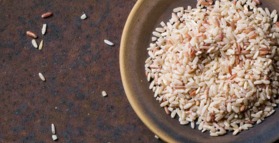 Arsenic and rice
Arsenic and rice
Posted on Tue, 25 Apr 17

Dietary arsenic exposure from rice is a possible health risk and minimizing dietary exposure could be important.
Exposure to arsenic from food sources is emerging as an important health risk, yet despite increasing concern there are no consumer guidelines that help people reduce exposure [1].
Rice is one of the most significant dietary sources of arsenic, which is naturally concentrated in the plant from the soil and groundwater during cultivation.
Inorganic arsenic, the major type of arsenic in rice, is a toxic metal that has been associated with increased risk for numerous diseases including various cancers, cardiovascular disease, and diabetes, at common levels of dietary exposure [2].
Several studies have found that eating more rice increases inorganic arsenic exposure. For example, eating 300 g of rice led to a 730% increase in urinary total arsenic excretion in adults [3] and approximately ½ a cup of cooked rice daily was estimated to provide just below the total threshold for arsenic exposure in US women [4].
A potential concern is the increasing popularity of gluten-free diet products which are frequently rice-based. A recent study found that people following a gluten-free diet have higher arsenic exposure [5]. And high consumption of rice-based gluten-free foods could result in arsenic toxicity [6].
To reduce potential risks we need more research into ways to reduce arsenic concentrations in rice. Additionally, individual health assessment and detoxification methods need to be considered.
For now, some simple ways to reduce risk would be to avoid heavy reliance on rice and rice-based foods, especially gluten-free products. Additionally, ensuring optimal intake of nutrients such as selenium, vitamin E, vitamin B12 and folate with a good multivitamin and mineral supplement may help arsenic detoxification [7]. As may chlorophyll-rich green leafy vegetables and foods such as spirulina [8].
References:
- Nachman KE, Ginsberg GL, Miller MD, Murray CJ, Nigra AE, Pendergrast CB. Mitigating dietary arsenic exposure: Current status in the United States and recommendations for an improved path forward. Sci Total Environ. 2017 Mar 1;581-582:221-236.
- Davis MA, Signes-Pastor AJ, Argos M, et al. Assessment of human dietary exposure to arsenic through rice. Sci Total Environ. 2017 May 15;586:1237-1244.
- Gilbert-Diamond D, Cottingham KL, Gruber JF, et al. Rice consumption contributes to arsenic exposure in US women. Proc Natl Acad Sci U S A. 2011 Dec 20;108(51):20656-60.
- Meharg AA, Williams PN, Deacon CM, et al. Urinary excretion of arsenic following rice consumption. Environ Pollut. 2014 Nov;194:181-7.
- Raehsler SL, Choung RS, Marietta EV, Murray JA. Accumulation of Heavy Metals in People on a Gluten-Free Diet. Clin Gastroenterol Hepatol. 2017 Feb 18. pii: S1542-3565(17)30186-6. doi: 10.1016/j.cgh.2017.01.034. [Epub ahead of print]
- Hasanato RM, Almomen AM. Unusual presentation of arsenic poisoning in a case of celiac disease. Ann Saudi Med. 2015 Mar-Apr;35(2):165-7.
- Carlin DJ, Naujokas MF, Bradham KD, et al. Arsenic and Environmental Health: State of the Science and Future Research Opportunities. Environ Health Perspect. 2016 Jul;124(7):890-9.
- Misbahuddin M, Islam AZ, Khandker S, et al. Efficacy of spirulina extract plus zinc in patients of chronic arsenic poisoning: a randomized placebo-controlled study. Clin Toxicol (Phila). 2006;44(2):135-41.
Tags: Arsenic, Rice, Detoxification




